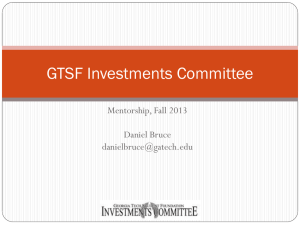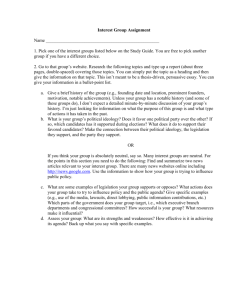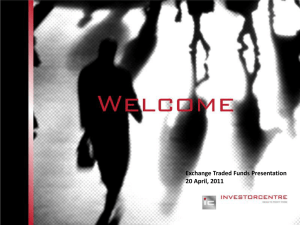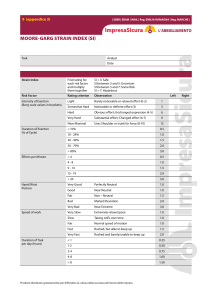Case for Value and Size Investing
advertisement
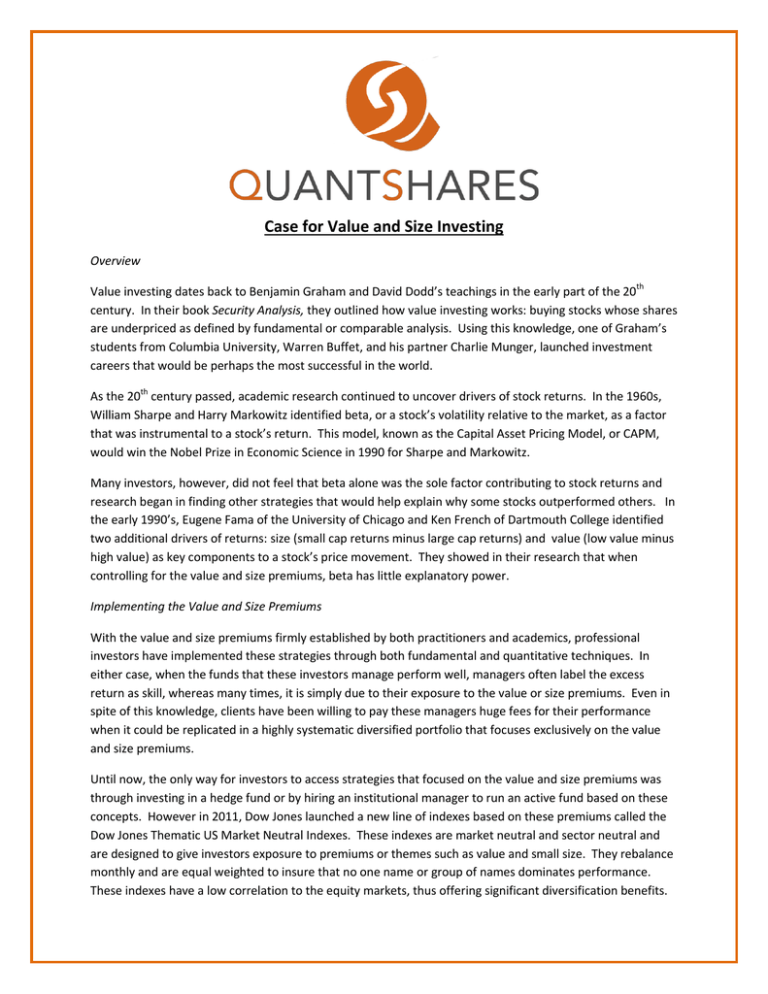
Case for Value and Size Investing Overview Value investing dates back to Benjamin Graham and David Dodd’s teachings in the early part of the 20th century. In their book Security Analysis, they outlined how value investing works: buying stocks whose shares are underpriced as defined by fundamental or comparable analysis. Using this knowledge, one of Graham’s students from Columbia University, Warren Buffet, and his partner Charlie Munger, launched investment careers that would be perhaps the most successful in the world. As the 20th century passed, academic research continued to uncover drivers of stock returns. In the 1960s, William Sharpe and Harry Markowitz identified beta, or a stock’s volatility relative to the market, as a factor that was instrumental to a stock’s return. This model, known as the Capital Asset Pricing Model, or CAPM, would win the Nobel Prize in Economic Science in 1990 for Sharpe and Markowitz. Many investors, however, did not feel that beta alone was the sole factor contributing to stock returns and research began in finding other strategies that would help explain why some stocks outperformed others. In the early 1990’s, Eugene Fama of the University of Chicago and Ken French of Dartmouth College identified two additional drivers of returns: size (small cap returns minus large cap returns) and value (low value minus high value) as key components to a stock’s price movement. They showed in their research that when controlling for the value and size premiums, beta has little explanatory power. Implementing the Value and Size Premiums With the value and size premiums firmly established by both practitioners and academics, professional investors have implemented these strategies through both fundamental and quantitative techniques. In either case, when the funds that these investors manage perform well, managers often label the excess return as skill, whereas many times, it is simply due to their exposure to the value or size premiums. Even in spite of this knowledge, clients have been willing to pay these managers huge fees for their performance when it could be replicated in a highly systematic diversified portfolio that focuses exclusively on the value and size premiums. Until now, the only way for investors to access strategies that focused on the value and size premiums was through investing in a hedge fund or by hiring an institutional manager to run an active fund based on these concepts. However in 2011, Dow Jones launched a new line of indexes based on these premiums called the Dow Jones Thematic US Market Neutral Indexes. These indexes are market neutral and sector neutral and are designed to give investors exposure to premiums or themes such as value and small size. They rebalance monthly and are equal weighted to insure that no one name or group of names dominates performance. These indexes have a low correlation to the equity markets, thus offering significant diversification benefits. QuantShares US Market Neutral ETFs The QuantShares US Market Neutral Value and Size ETFs provide all investors with access to the value and size premiums by tracking their respective Dow Jones Thematic index. Each fund provides all of the benefits of an ETF structure: full transparency, daily liquidity, and low expenses. As market neutral funds, they also offer low correlation to the equity markets and lower volatility. Below are brief descriptions of each ETF. QuantShares US Market Neutral Value ETF The QuantShares US Market Neutral Value ETF follows the Dow Jones US Market Neutral Value Index. The ETF buys stocks that have low valuations based on three different metrics: Price to Forward Earnings, Price to Book, and Price to Cash Flow. The ETF shorts stocks that have high valuations based on the same ratios. Each security is roughly 0.50% of the fund and the fund takes an equal amount of long and short positions in each sector. The fund rebalances monthly and is market neutral having equal exposure to long securities, short securities and cash at each rebalance. The fund earns a positive return when the basket of cheap stocks outperforms the basket of expensive ones, regardless of market direction. 12/31/13 - QuantShares US Market Neutral Value ETF (CHEP) Characteristics Number of Companies Price to Book Forward Earnings Yield (E/P) Beta Average Market Cap (millions) Median Market Cap (millions) Sector Energy Basic Materials Industrials Consumer Goods Health Care Consumer Services Telecommunications Utilities Financials Technology Source: Bloomberg Long 200 1.53 12.43 1.14 $ 22,801 $ 8,196 Short 200 6.49 33.97 1.10 $ 15,705 $ 8,085 Long 8.03% 4.51% 18.04% 10.03% 9.02% 14.54% 1.00% 4.51% 19.54% 11.02% Short -8.03% -4.52% -18.03% -10.03% -9.05% -14.56% -1.00% -4.52% -19.53% -11.02% QuantShares US Market Neutral Size ETF (SIZ) The QuantShares US Market Neutral Size ETF follows the Dow Jones US Market Neutral Size Index. The ETF buys stocks that have low market capitalizations and shorts stocks that have high market capitalizations. Each security is roughly 0.50% of the fund and the fund takes an equal amount of long and short positions in each sector. The fund rebalances monthly and is market neutral having equal exposure to long securities, short securities and cash at each rebalance. The fund earns a positive return when the basket of smaller cap stocks outperforms the basket of larger cap ones, regardless of market direction. 12/31/13 - QuantShares US Market Neutral Size ETF (SIZ) Characteristics Long Short Number of Companies 200 200 Price to Book 2.35 2.78 Forward Earnings Yield (E/P) 19.49 17.01 Beta 1.14 1.03 Average Market Cap (millions) $ 3,223 $ 69,920 Median Market Cap (millions) $ 3,197 $ 40,631 Long 7.53% 4.51% 18.06% 10.06% 9.01% 14.04% 1.51% 5.00% 19.53% 11.02% Short -7.53% -4.53% -18.08% -10.03% -9.04% -14.05% -1.51% -5.01% -19.60% -11.02% Sector Energy Basic Materials Industrials Consumer Goods Health Care Consumer Services Telecommunications Utilities Financials Technology Source: Bloomberg Implementing the Strategies Implementing the Value (CHEP) and Size (SIZ) strategies is easy since both these ETFs trade on the NYSE. The strategies effectively complement an investor’s strategic core positions, due to their low correlation to the equity and bond markets and their solid and consistent risk adjusted returns. For more information on the benefits of implementing QuantShares ETFs into your own asset allocation please call Kevin Collins at 617292-9801. Before investing you should carefully consider the Fund’s investment objectives, risks, charges and expenses. This and other information is in the Fund’s prospectus which can be obtained at www.quantshares.com. Please read the prospectus carefully before you invest. Foreside Fund Services, LLC, Distributor Shares are not individually redeemable and can be redeemed only in Creation Units. The market price of shares can be at, below or above the NAV. Market Price returns are based upon the midpoint of the bid/ask spread at 4:00PM eastern time (when NAV is normally determined), and do not represent the returns you would receive if you traded shares at other times. Fund returns assume that dividends and capital gains distributions have been reinvested in the Fund at NAV. Some performance results reflect expense subsidies and waivers in effect during certain periods. Absent these waivers, results would have been less favorable. Risks: There is no guarantee that the funds will achieve their objective. Investing involves risk, including possible loss of principal. There is a risk that during a “bull” market, when most equity securities and long only ETFs are increasing in value, the Funds’ short positions will likely cause the Fund to underperform the overall U.S. equity market and such ETFs. There may be periods when the value style is out of favor, and during which the investment performance of a fund using a value strategy may suffer. These securities may be more volatile than a broad cross-section of securities. The Funds may not be suitable for all investors. Short selling could cause unlimited losses, derivatives could result in losses beyond the amount invested, and the value of an investment in the Fund may fall sharply. Beta is a measure of an asset’s sensitivity to an underlying index.


